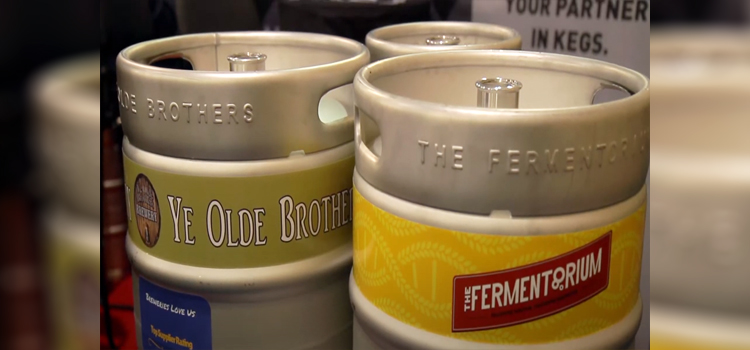Last Updated on March 17, 2024 by Lydia Martin
Different keg sizes serve varying purposes and can be used in different situations. But if you don’t know what to use for the purpose you have in mind, you better know the sizes and capacities of each keg. So, here we detail how many ounces in a keg to help you identify the right barrel according to your needs.
Table of Contents
ToggleHow Many Ounces Are In A Keg?

The number of ounces in a keg varies depending on its size. There are seven different keg sizes, and each keg can hold a specific volume of beer.
The Mini keg, the smallest in size, can hold up to 169 oz of beer, while the Half-Barrel keg, the largest in size, can hold up to 1,984 oz of beer.
How Many Ounces Are In Different Keg Sizes?
Sixth Barrel Keg
Ounces: 661 oz = 41 (16oz) glasses or 55 (12oz) cans/bottles
The Sixth Barrel Keg is commonly used in dual or triple-tap setups. Like the Cornelius Keg, this smaller one functions like its bigger cousins. It only holds less beer than other similar-sized containers.
This size can be used for bars and restaurants with limited space but still want a large selection of beer available to their customers.
50 Litre Keg

Ounces: 1690 oz = 105 (16oz) glasses or 140 (120z) cans/bottles
The 50 Liter Keg is commonly used by European breweries and is similar to the Half Barrel in size. This type of container is most commonly found in the UK and other European countries.
Some of the popular imports from the US include Stella Artois, Newcastle, Hoegaarden, and Heineken.
But you should know that import kegs do not utilize a standard Sankey D-type coupling.
Slim Quarter Keg
Ounces: 992 oz = 62 (16oz) glasses or 82 (12oz) cans/bottles
The Slim Quarter Keg is similar to the Quarter barrel in size. So, this makes it a popular choice among dual-tapers.
“A bottle of beer contains more philosophy than all the books in the world.”
— Louis Pasteur, French Chemist
Besides, Slim Quarter Kegs are tall and skinny versions of the Sixth Barrel. Its slightly larger width allows it to hold an additional two gallons of beer.
Cornelius Keg
Ounces: 640 oz = 40 (16oz) glasses or 53 (12oz) cans/bottles
Originally developed for the soft drink industry, people who make beer or soda at home often use these. Cornelius Keg is easy to clean and fill up.
It comes in two types of connectors: pin-lock and ball-lock.
Half Barrel Keg

Ounces: 1984 oz = 124 (16oz) glasses or 165 (12oz) cans/bottles
This Half Barrel Keg is the most common type of beer container people think of when picturing a beer keg.
Actually, it’s a vessel that’s been used to distribute macro-brews for many years.
Also, this is a standard-sized beer keg that most establishments use. It fits most standard-sized containers.
So if you plan on trying new recipes, you might want to use the smaller sizes.
Mini Keg
Ounces: 169 oz = 10 (16oz) glasses or 14 (12oz) cans/bottles
The Mini Keg is ideal for portable or one-time use. It can be used for a variety of activities, such as watching the game with friends or hosting a small dinner party.
Unfortunately, finding a specific beer is not always easy with these.
Quarter Barrel Keg

Ounces: 992 oz = 62 (16oz) glasses or 82 (12oz) cans/bottles
The Quarter Barrel is a stubby and shorter keg. Compared to a Full Barrel, it measures 16 1/8 inches wide and about 10 inches shorter in height.
Alternative names for Quarter Barrel Keg are Pony Keg, Stubby Quarter, or 1/4 BBL.
Keg Sizes & Capacity Quick Reference Chart
| Keg Name | Capacity (Oz) |
| Sixth Barrel Keg | 661 oz |
| 50 Litre Keg | 1,690 oz |
| Slim Quarter Keg | 992 oz |
| Cornelius Keg | 640 oz |
| Half Barrel Keg | 1,984 oz |
| Mini Keg | 169 oz |
| Quarter Barrel Keg | 992 oz |
Frequently Asked Questions (FAQs)
How many ounces is in a full keg?
A full keg typically contains 1984 fluid ounces, but this can vary depending on the type of keg and its dimensions.
Keg sizes can differ, with some holding slightly more or less than this standard measurement.
It’s essential to verify the specific capacity of the keg in question, as it may vary based on factors like its shape and manufacturer specifications.
How many 12 oz beers in a keg?
With a standard keg size, which holds 1984 fluid ounces, you can expect to get approximately 165 12-ounce servings. However, this number may fluctuate slightly based on factors such as the shape of the keg and the amount of headspace.
Kegs are designed to efficiently store and dispense beer, with the capacity to provide a substantial number of servings for events, parties, or commercial purposes.
Understanding the number of servings per keg is crucial for planning and budgeting purposes, whether you’re a bar owner, event planner, or hosting a gathering at home.
What is a standard keg size?
The most common size for a standard keg used in commercial settings is the half-barrel keg, which holds around 15.5 gallons or 1984 fluid ounces of liquid. This size is prevalent in bars, restaurants, and at large gatherings. However, it’s essential to note that there are other keg sizes available, each serving different needs.
For instance, quarter-barrel and sixth-barrel kegs are smaller options suitable for smaller venues or home use, while larger options like full-barrel kegs are utilized for significant events or in high-volume establishments.
Understanding the various keg sizes can help ensure you select the right option for your specific requirements, whether you’re stocking a bar, hosting a party, or serving beverages at an event.
How many liters is a keg?
A standard keg size, such as the half-barrel keg, holds approximately 58.7 liters of liquid. However, it’s essential to note that there are various keg sizes available, each with its own capacity, ranging from smaller sizes like quarter-barrel and sixth-barrel kegs to larger options such as the full-barrel keg.
The measurement in liters provides an alternative perspective on the volume of liquid a keg can hold, particularly useful in international contexts where the metric system is more commonly used.
Understanding the volume in liters can facilitate communication and ensure clarity when discussing keg sizes and capacities across different regions and markets.
What is a full size full barrel keg?
A full-size, full-barrel keg, also known simply as a barrel, typically holds 31 gallons of liquid. This size is more common in brewing and distilling contexts rather than for serving directly to consumers.
It’s worth noting that the term “barrel” can also refer to other sizes, such as the half-barrel keg commonly used for commercial beer distribution.
How many does a full keg serve?
A full keg, which typically contains 15.5 gallons or 1984 fluid ounces of liquid, can serve approximately 165 12-ounce servings.
This estimation may vary depending on factors such as the type of beverage being served, the size of the servings, and individual pouring practices.
What is the difference between a keg and a barrel?
The terms “keg” and “barrel” are often used interchangeably, but they actually refer to different sizes of containers for storing and dispensing liquids.
A keg is a smaller container, typically used in commercial settings and for personal use, holding around 15.5 gallons or 1984 fluid ounces of liquid. On the other hand, a barrel is a larger container, often used in brewing and distilling contexts, with a standard size of 31 gallons.
While both kegs and barrels serve similar purposes, they differ in size and are utilized in different stages of production and distribution.
How heavy is a full keg?
A full keg, when filled with liquid, can weigh approximately 160 pounds (72.5 kilograms) on average.
However, the weight may vary slightly depending on factors such as the type of beverage being stored and the dimensions of the keg itself.
It’s important to consider the weight of a full keg when handling and transporting it, as it requires proper equipment and precautions to ensure safety.
How do you measure a keg of beer?
Measuring a keg of beer typically involves determining its volume, which is commonly expressed in gallons or liters.
The most common size for kegs is the half-barrel, which holds approximately 15.5 gallons or 58.67 liters of beer.
Other sizes include quarter-barrels, which hold around 7.75 gallons or 29.34 liters, and sixth-barrels, holding about 5.16 gallons or 19.53 liters. These measurements are crucial for managing inventory, pricing, and serving calculations in the hospitality industry.
How many beers are in a keg?
The number of beers in a keg depends on several factors, including the keg’s size and the serving size of each beer. A standard serving size for a beer is 12 ounces.
Using this serving size, a half-barrel keg, which contains approximately 15.5 gallons or 1,984 ounces of beer, could yield around 165 12-ounce servings. A quarter-barrel keg would yield about half that number, or 82 servings, while a sixth-barrel keg would provide roughly 55 servings.
However, factors such as beer foam, spillage, and variations in pour size can affect the actual number of servings obtained from a keg.
How long will a keg last?
The lifespan of a keg depends on several variables, including the rate of consumption, the size of the keg, and how the beer is stored and dispensed. In general, a keg of beer can last for several weeks if stored properly and kept under the appropriate temperature and pressure conditions.
Factors such as exposure to light, temperature fluctuations, and the presence of oxygen can accelerate the beer’s degradation and affect its taste.
Once a keg is tapped and exposed to air, it is best consumed within a few days to maintain optimal freshness and flavor.
What is the most popular keg?
The half-barrel keg, also known as a full-size keg, is one of the most popular keg sizes worldwide. Its large capacity makes it suitable for serving beer at events, parties, and commercial establishments. Breweries and distributors often prefer this size due to its efficiency in storage and transportation.
Additionally, the half-barrel keg is commonly used in bars, pubs, and restaurants for its convenience and cost-effectiveness.
Its popularity stems from its ability to provide a substantial quantity of beer while minimizing the need for frequent replacements, making it a staple in the beer industry.
What is a full size full barrel keg?
A full-size, full-barrel keg, commonly referred to as simply a “barrel,” typically holds 31 gallons of liquid. These larger containers are primarily utilized within brewing and distilling industries for storage and transportation purposes rather than direct consumption.
It’s important to note that while the term “keg” is often used interchangeably with “barrel,” they represent distinct sizes, with barrels being notably larger.
How many does a full keg serve?
A full keg, typically containing 15.5 gallons or 1984 fluid ounces of liquid, serves approximately 165 12-ounce servings.
This estimate serves as a practical guideline for event planning, providing insight into the volume of beverages required to accommodate guests.
However, serving quantities may vary based on factors such as pour size and beverage type.
What is the difference between a keg and a barrel?
The distinction between a keg and a barrel lies primarily in their respective sizes and applications. A keg typically refers to a smaller container, commonly used in commercial settings and for personal consumption, with a standard size of around 15.5 gallons.
Conversely, a barrel is a larger vessel, often utilized in brewing and distilling contexts, holding approximately 31 gallons of liquid.
While both kegs and barrels serve as vessels for storing and dispensing liquids, their differing sizes cater to various stages of production and distribution within the beverage industry.
How heavy is a full keg?
A full keg, when filled with liquid, typically weighs around 160 pounds (72.5 kilograms) on average.
This weight may vary slightly based on factors such as beverage type and keg dimensions.
Considering the substantial weight of a full keg is crucial for safe handling and transportation, necessitating appropriate equipment and precautions to prevent injury or damage.
How many pots in a keg?
A standard keg typically contains around 124 pints or 15.5 gallons of beer.
This translates to approximately 165 12-ounce servings or 1240 fluid ounces. However, sizes can vary, with smaller kegs holding as little as 5 gallons.
How many kegs per person?
The number of kegs needed per person largely depends on factors such as the duration of the event, the number of attendees, and their drinking habits. As a rough estimate, a standard keg can serve around 165 12-ounce servings.
For a party with 100 guests consuming an average of two drinks per hour over a four-hour period, approximately 8 kegs might be necessary.
It’s essential to consider the preferences and behaviors of the attendees to ensure an adequate supply.
Why is beer better from a keg?
Beer from a keg is often perceived as fresher and of higher quality due to several factors. Firstly, kegs are typically stored under pressure, preventing oxidation and maintaining the beer’s freshness for longer periods compared to bottles or cans.
Additionally, kegs are commonly used by bars and breweries equipped with draft systems, ensuring that the beer is dispensed at the optimal temperature and carbonation level, enhancing its flavor and aroma.
Furthermore, the process of kegging beer involves minimal exposure to light and air, which can degrade its quality, resulting in a crisper and more flavorful brew.
Why is keg more expensive than cask?
Several factors contribute to the higher cost of kegs compared to casks. Firstly, kegs are typically made of durable stainless steel, which is more expensive than the materials used in traditional casks, such as wood or plastic.
Additionally, kegs often require specialized equipment for storage, transportation, and dispensing, adding to their overall cost. Moreover, the process of kegging beer involves additional steps such as cleaning, sanitizing, and pressurizing, which can increase production expenses.
Furthermore, kegs are commonly associated with larger commercial breweries that incur higher overhead costs, including marketing and distribution, which are reflected in the pricing of kegged beer.
Despite the higher upfront cost, kegs offer several advantages over casks, including superior durability, consistency in dispense quality, and longer shelf life, making them a preferred choice for many breweries and venues.
Why do you need CO2 for a keg?
CO2 (carbon dioxide) is essential for kegs because it serves multiple crucial purposes in the dispensing and preservation of beer.
Firstly, CO2 is used to pressurize the keg, maintaining a constant pressure that allows the beer to flow smoothly from the tap. This pressure also prevents the beer from going flat by keeping it carbonated.
Additionally, CO2 acts as a barrier against oxygen, which can degrade the flavor and quality of the beer, ensuring that it remains fresh and flavorful throughout the dispensing process.
Furthermore, CO2 is often used to purge air from the empty keg before filling, minimizing the risk of oxidation and contamination, which could compromise the beer’s taste and shelf life.
So, How Many Ounces In A Keg?
Now you know what keg size you’ll opt for, the next step is to ensure that you’re keg coupler on your draft system or kegerator [2] is compatible with the keg size you’ll use.
Know that most local beers fit the D Sankey System Coupler, the standard of most kegerators.
Choose the keg size that best suits your needs and is compatible with your kegerator for a seamless beer process.
References:
















